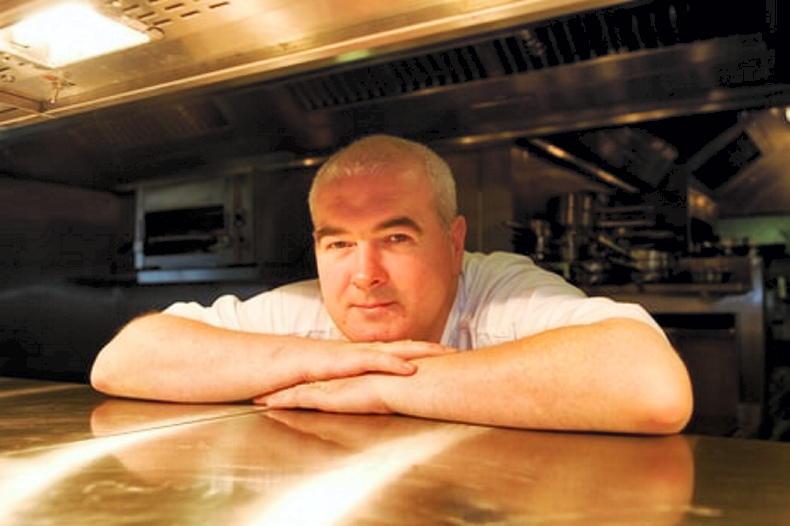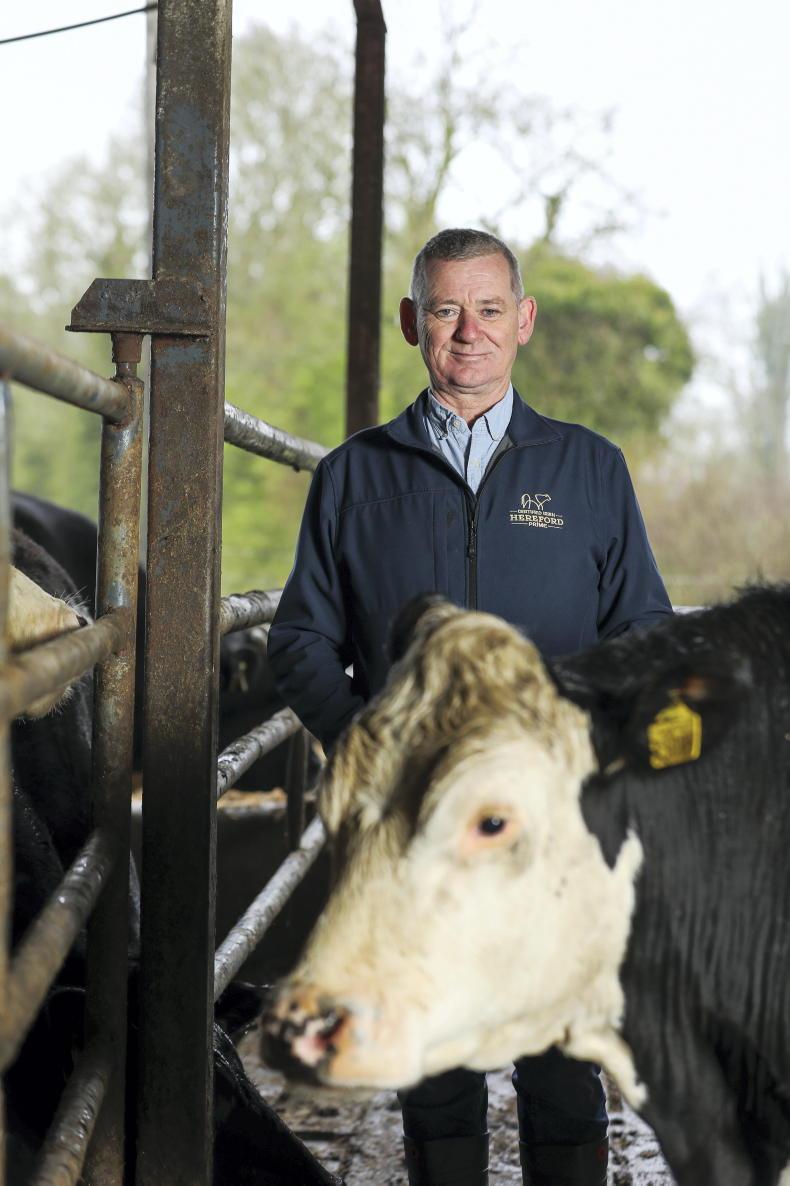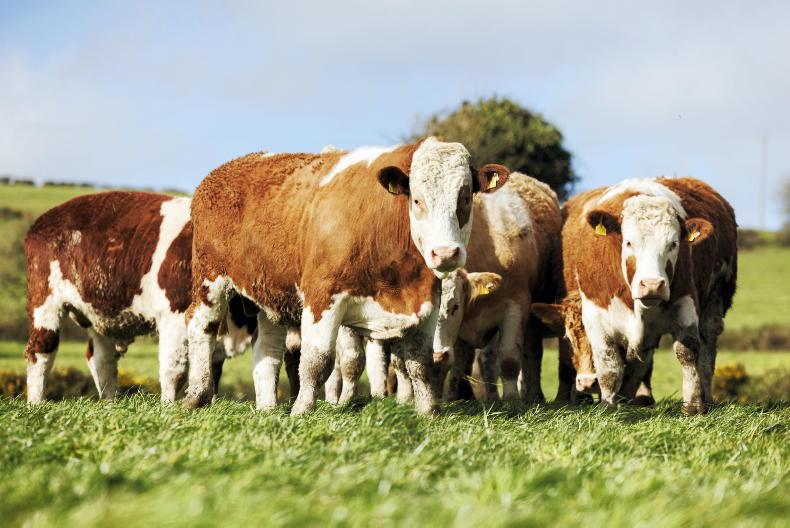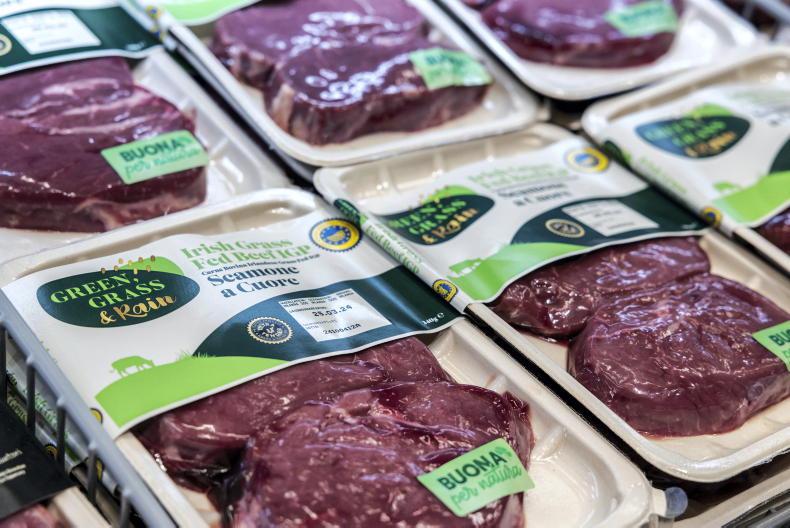I am now celebrating over a decade in Ireland, having moved here from Canada in 2013. I can still remember my first taste of Irish beef.
“It’s the beefiest-tasting beef I’ve ever had,” I declared to my husband.
Eleven years later, I still stand by this statement, and it makes Noreen Lanigan, a Holycross, Co Tipperary native and Bord Bia’s regional manager for Europe and North America, laugh as we chat over Zoom from the Bord Bia office in Paris, where she has been living and working with the Irish food board for the past three decades.
“There’s the headline for your article,” she states, before we return to the discussion at hand: the recent all-island PGI recognition of Irish Grass-Fed Beef.
What is PGI?
PGI, or Protected Geographical Indication, is one of several quality schemes for food and drink covered by the EU. Others include PDO (Protected Designation of Origin) and GI (Geographical Indication). PGI products indicate a strong relationship between a product, its region, and the special qualities it exhibits due to this relationship.
In November 2023, Minister for Agriculture, Food and the Marine (DAFM) Charlie McConalogue announced that the application for an all-island PGI for grass-fed beef had been successful. Two previous attempts to register beef from the Republic alone had been unsuccessful. Noreen believes that this time around, taking the whole-island approach made all the difference.

Noreen Lanigan
“The specific land and approach to grassland management is similar north and south of the border,” she says. “Based on feedback during this application process, we were happy to change it to include grass-fed beef produced on the island of Ireland.”
The application was a collaborative affair between the DAFM, DAERA (Northern Ireland’s Department of Agriculture, Environment and Rural Affairs), DEFRA (United Kingdom’s Department of Environment, Food and Rural Affairs), Bord Bia and the Livestock and Meat Commission.
“During the pandemic, we had developed a new standard for Irish beef called the Grass-Fed Verified Standard,” Noreen explains. “When you go abroad, consumers assume all cattle eat grass, but nobody had a way of proving it.
“It’s hard for Irish beef to stand out if consumers think all beef is grass-fed, so this new standard allowed us to calculate how many average days Irish beef cattle were on grass and what percentage of grass was in their diet,” she continues. “We had the data and the mechanism to measure it, so the idea came around to make a new application for the PGI – it gave us a differentiator we could prove, because these days, everything is about substantiation.”
Bord Bia estimates that up to 50% of the prime beef produced in Ireland could qualify for the PGI.
Enforcement
Whether a farm qualifies for PGI status will be down to their Sustainable Beef and Lamb Assurance Scheme (SBLAS) audit by Bord Bia. The data from the audit will link in with operating systems at processing sites to determine if an animal qualifies. Processors must be members of the Bord Bia Food Processor Standard and will be audited by DAFM to qualify for PGI beef processing. Currently, just one processor – ABP in Cahir – is audited to process PGI beef.
Italy was chosen as the first export market for the PGI beef because consumer awareness of PGI is high in Italy, they are willing to pay more for premium beef and they are not self-sufficient in beef so there is demand for imported beef.
“There is a retailer in Italy which already has the PGI on shelf, which I think is pretty quick turnaround,” Noreen says. “This is a good start and a good way to showcase that PGI beef is now launched, for other potential customers.”
With its consumer research, Bord Bia found that southern European countries like Italy, France and Spain have the highest PGI awareness in Europe. They extended this research to the United States and Japan, but found little awareness of PGI within these markets.
As Ireland is part of the European Union and Bord Bia makes use of public funds, it had to adhere to anti-competition rules when promoting the virtues of Irish beef. This means it often had to tone down the “Irish” messaging in its marketing; instead using our Quality Assurance Scheme to promote the product.
Noreen says obtaining the PGI status enables Bord Bia to put the “Irishness” of our beef front and centre.
“Every country we play in has their own quality standards,” she adds. “We can’t always qualify to get their standard. The PGI takes us out of that quandary. It means we have that endorsement from Brussels – that we have something unique – and it brings us to a new competitive space.”
What makes Irish beef so special?
The fact that our cattle spend so much time eating fresh grass contributes to the unique qualities of Irish beef. Bord Bia’s consumer taste tests have found that for flavour, meat-to-fat ratio and texture, grass-fed Irish beef rates highly among European consumers. Nutritionally speaking, Teagasc has also found that grass-fed Irish beef is higher in Omega-3 fatty acids, minerals and vitamins than cattle raised on lower-grass diets.

Gareth Byrne owns and operates Michelin Star restaurant Campagne in Kilkenny
At the end of the day, though, it all comes down to the end consumer. Chef Gareth Byrne owns and operates Campagne in Kilkenny; a restaurant which has long held a Michelin Star and has always had Irish beef on the menu. He says Irish grass-fed beef is deserving of its excellent reputation both at home and abroad.
“These days, there’s a lot more emphasis on traceability and I think this is a good thing, both for chefs and consumers,” he tells Irish Country Living. “It has great texture and depth of flavour, which you just don’t get in other beef. I’m a big fan of slow cooking; I love using less-popular cuts like cheeks, ribs or ox tail, but on our à la carte menu, we always have the fillet. I’d say we use around 90% Hereford beef, and 99% of our beef comes directly from here in Kilkenny.”
In terms of the PGI status, Gareth says many of the non-farming community may be aware that we have achieved it, but they would not know the level of detail which goes in to being assessed. Consumers might not fully understand the concept of grass-fed beef or what goes into raising a quality grass-fed animal. Overall, though, the PGI is a great achievement for Irish beef.
“Irish beef is a world competer – it’s a world-class product,” he says. “It’s something we should be proud of.”
The farmer’s view: ‘It’s a great validation of what we have had for years’
Michael says the recent PGI recognition can only be a good thing for Irish beef farmers \ Odhran Ducie
Michael Cleary is no stranger to raising high-quality Irish beef. A farmer for over 40 years, he says his family have always believed that grass is not only the most cost-effective feed, but is the best nutritional option for their herd.
“I started farming with my father in the early 1980s,” he says. “That’s my life – I love the cattle game more than any other type of farming.”
Importance of grass
In addition to farming, for the past 20 years Michael has worked with the Irish Hereford Prime producer group. He tells Irish Country Living that much of his work brings him around the country on visits to the 6,000 other Hereford Prime farmers. While he has been able to assist many farmers over the years, he says he has equally learned a great deal from visiting other farms.
“We are very good at growing grass here in Ireland, and I have learned so much from talking to other farmers,” he says.
As the PGI recognition is so new, very few farmers are currently signed on to it. Michael believes that as we learn more in the coming months, we will likely see an increase in farmers putting their beef forward for assessment.
Overall, he says achieving PGI status for grass-fed beef can only be a positive thing for Irish beef farmers going forward.
“One thing I have found over the last 10 years is the importance of grass in the animal’s diet,” he says. “If you look at the PGI, I think it’s great for this country. It’s a great validation of what we have had for years.
“We have all different types of farmers here – big and small – but they all do the job so well. I think that makes a difference to the end consumer, as well.”
Grass-fed PGI standards: what’s required
Cattle grazing fresh grass at Shanacoole, Youghal, Co Cork \ Donal O’ Leary
Farms that qualify for the PGI status will adhere to the following:
The cattle must be born and raised on grassThe cattle must be finished, slaughtered, and beef chilled and quartered on the island of IrelandIn their lifetime, the cattle must spend an average of 220 days per year on grass at pasture The cattle’s diet must be a minimum of 90% grass – primarily grazed grass, with some “wilted grass” (silage) for winter feedingSteers and heifers must have a conformation better than O- and a fat score between 2+ and 4+ (up to 36 months of age)Beef cows must have a conformation better than O+ and a fat score between 2+ and 5 (up to 120 months of age)Meat maturation must be a minimum of 48 hours (72 hours for hind cuts)Each animal must be assessed to meet the grass-fed standard
Irish Grassland Fed Beef (PGI)
In addition to Irish Grass-Fed Beef, the following Irish food also enjoy PGI status:
Clare Island SalmonConnemara Hill LambIrish PoitínIrish WhiskeySneem Black PuddingTimoleague Brown PuddingWaterford Blaa
I am now celebrating over a decade in Ireland, having moved here from Canada in 2013. I can still remember my first taste of Irish beef.
“It’s the beefiest-tasting beef I’ve ever had,” I declared to my husband.
Eleven years later, I still stand by this statement, and it makes Noreen Lanigan, a Holycross, Co Tipperary native and Bord Bia’s regional manager for Europe and North America, laugh as we chat over Zoom from the Bord Bia office in Paris, where she has been living and working with the Irish food board for the past three decades.
“There’s the headline for your article,” she states, before we return to the discussion at hand: the recent all-island PGI recognition of Irish Grass-Fed Beef.
What is PGI?
PGI, or Protected Geographical Indication, is one of several quality schemes for food and drink covered by the EU. Others include PDO (Protected Designation of Origin) and GI (Geographical Indication). PGI products indicate a strong relationship between a product, its region, and the special qualities it exhibits due to this relationship.
In November 2023, Minister for Agriculture, Food and the Marine (DAFM) Charlie McConalogue announced that the application for an all-island PGI for grass-fed beef had been successful. Two previous attempts to register beef from the Republic alone had been unsuccessful. Noreen believes that this time around, taking the whole-island approach made all the difference.

Noreen Lanigan
“The specific land and approach to grassland management is similar north and south of the border,” she says. “Based on feedback during this application process, we were happy to change it to include grass-fed beef produced on the island of Ireland.”
The application was a collaborative affair between the DAFM, DAERA (Northern Ireland’s Department of Agriculture, Environment and Rural Affairs), DEFRA (United Kingdom’s Department of Environment, Food and Rural Affairs), Bord Bia and the Livestock and Meat Commission.
“During the pandemic, we had developed a new standard for Irish beef called the Grass-Fed Verified Standard,” Noreen explains. “When you go abroad, consumers assume all cattle eat grass, but nobody had a way of proving it.
“It’s hard for Irish beef to stand out if consumers think all beef is grass-fed, so this new standard allowed us to calculate how many average days Irish beef cattle were on grass and what percentage of grass was in their diet,” she continues. “We had the data and the mechanism to measure it, so the idea came around to make a new application for the PGI – it gave us a differentiator we could prove, because these days, everything is about substantiation.”
Bord Bia estimates that up to 50% of the prime beef produced in Ireland could qualify for the PGI.
Enforcement
Whether a farm qualifies for PGI status will be down to their Sustainable Beef and Lamb Assurance Scheme (SBLAS) audit by Bord Bia. The data from the audit will link in with operating systems at processing sites to determine if an animal qualifies. Processors must be members of the Bord Bia Food Processor Standard and will be audited by DAFM to qualify for PGI beef processing. Currently, just one processor – ABP in Cahir – is audited to process PGI beef.
Italy was chosen as the first export market for the PGI beef because consumer awareness of PGI is high in Italy, they are willing to pay more for premium beef and they are not self-sufficient in beef so there is demand for imported beef.
“There is a retailer in Italy which already has the PGI on shelf, which I think is pretty quick turnaround,” Noreen says. “This is a good start and a good way to showcase that PGI beef is now launched, for other potential customers.”
With its consumer research, Bord Bia found that southern European countries like Italy, France and Spain have the highest PGI awareness in Europe. They extended this research to the United States and Japan, but found little awareness of PGI within these markets.
As Ireland is part of the European Union and Bord Bia makes use of public funds, it had to adhere to anti-competition rules when promoting the virtues of Irish beef. This means it often had to tone down the “Irish” messaging in its marketing; instead using our Quality Assurance Scheme to promote the product.
Noreen says obtaining the PGI status enables Bord Bia to put the “Irishness” of our beef front and centre.
“Every country we play in has their own quality standards,” she adds. “We can’t always qualify to get their standard. The PGI takes us out of that quandary. It means we have that endorsement from Brussels – that we have something unique – and it brings us to a new competitive space.”
What makes Irish beef so special?
The fact that our cattle spend so much time eating fresh grass contributes to the unique qualities of Irish beef. Bord Bia’s consumer taste tests have found that for flavour, meat-to-fat ratio and texture, grass-fed Irish beef rates highly among European consumers. Nutritionally speaking, Teagasc has also found that grass-fed Irish beef is higher in Omega-3 fatty acids, minerals and vitamins than cattle raised on lower-grass diets.

Gareth Byrne owns and operates Michelin Star restaurant Campagne in Kilkenny
At the end of the day, though, it all comes down to the end consumer. Chef Gareth Byrne owns and operates Campagne in Kilkenny; a restaurant which has long held a Michelin Star and has always had Irish beef on the menu. He says Irish grass-fed beef is deserving of its excellent reputation both at home and abroad.
“These days, there’s a lot more emphasis on traceability and I think this is a good thing, both for chefs and consumers,” he tells Irish Country Living. “It has great texture and depth of flavour, which you just don’t get in other beef. I’m a big fan of slow cooking; I love using less-popular cuts like cheeks, ribs or ox tail, but on our à la carte menu, we always have the fillet. I’d say we use around 90% Hereford beef, and 99% of our beef comes directly from here in Kilkenny.”
In terms of the PGI status, Gareth says many of the non-farming community may be aware that we have achieved it, but they would not know the level of detail which goes in to being assessed. Consumers might not fully understand the concept of grass-fed beef or what goes into raising a quality grass-fed animal. Overall, though, the PGI is a great achievement for Irish beef.
“Irish beef is a world competer – it’s a world-class product,” he says. “It’s something we should be proud of.”
The farmer’s view: ‘It’s a great validation of what we have had for years’
Michael says the recent PGI recognition can only be a good thing for Irish beef farmers \ Odhran Ducie
Michael Cleary is no stranger to raising high-quality Irish beef. A farmer for over 40 years, he says his family have always believed that grass is not only the most cost-effective feed, but is the best nutritional option for their herd.
“I started farming with my father in the early 1980s,” he says. “That’s my life – I love the cattle game more than any other type of farming.”
Importance of grass
In addition to farming, for the past 20 years Michael has worked with the Irish Hereford Prime producer group. He tells Irish Country Living that much of his work brings him around the country on visits to the 6,000 other Hereford Prime farmers. While he has been able to assist many farmers over the years, he says he has equally learned a great deal from visiting other farms.
“We are very good at growing grass here in Ireland, and I have learned so much from talking to other farmers,” he says.
As the PGI recognition is so new, very few farmers are currently signed on to it. Michael believes that as we learn more in the coming months, we will likely see an increase in farmers putting their beef forward for assessment.
Overall, he says achieving PGI status for grass-fed beef can only be a positive thing for Irish beef farmers going forward.
“One thing I have found over the last 10 years is the importance of grass in the animal’s diet,” he says. “If you look at the PGI, I think it’s great for this country. It’s a great validation of what we have had for years.
“We have all different types of farmers here – big and small – but they all do the job so well. I think that makes a difference to the end consumer, as well.”
Grass-fed PGI standards: what’s required
Cattle grazing fresh grass at Shanacoole, Youghal, Co Cork \ Donal O’ Leary
Farms that qualify for the PGI status will adhere to the following:
The cattle must be born and raised on grassThe cattle must be finished, slaughtered, and beef chilled and quartered on the island of IrelandIn their lifetime, the cattle must spend an average of 220 days per year on grass at pasture The cattle’s diet must be a minimum of 90% grass – primarily grazed grass, with some “wilted grass” (silage) for winter feedingSteers and heifers must have a conformation better than O- and a fat score between 2+ and 4+ (up to 36 months of age)Beef cows must have a conformation better than O+ and a fat score between 2+ and 5 (up to 120 months of age)Meat maturation must be a minimum of 48 hours (72 hours for hind cuts)Each animal must be assessed to meet the grass-fed standard
Irish Grassland Fed Beef (PGI)
In addition to Irish Grass-Fed Beef, the following Irish food also enjoy PGI status:
Clare Island SalmonConnemara Hill LambIrish PoitínIrish WhiskeySneem Black PuddingTimoleague Brown PuddingWaterford Blaa












 This is a subscriber-only article
This is a subscriber-only article










SHARING OPTIONS: